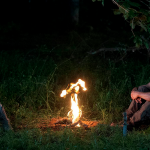Erin Newcomb makes a case for the virtue, humanness, and theological richness of scary stories, and urges us to follow Neil Gaiman’s advice to give a scary book to someone on Halloween.
“The night was cold and dark.
‘Listen to the wind howling in the trees,’ said Frog. ‘What a fine time for a ghost story.’
Toad moved deeper into his chair.
‘Toad,’ asked Frog, ‘don’t you like to be scared? Don’t you like to feel the shivers?’”
Whether Toad likes to feel the shivers or not, I shall leave up to the reader to discover. I will say that even beginning with the premise of a ghost story, “The Shivers” is not the most frightening of Arnold Lobel’s Frog and Toad stories, which often grapple with deep-seated anxieties about loneliness, abandonment, and loss. My three-year-old loves to feel the shivers, with this story and others. Yet when I started reading fairy tales to her, I edited them. I took out the part where the first two little pigs get eaten by the wolf, but numerous re-readings and my daughter’s adept memory soon ended that practice. I couldn’t keep up with all of my extemporaneous revisions, and I soon started to wonder if I was trying to protect my daughter or myself from the real text. It seemed like I had to decide forever betwixt two things—read the story or not. All right then, I thought, I’ll go to hell. And we all got the shivers.
Now, I’m not suggesting that parents read Stephen King to their toddlers, but I am making a case for discerning age-appropriate shiver-inducing reading for children and adults. That is the premise behind Neil Gaiman’s (one of my all-time favorite writers) proposed “All Hallow’s Read”: this Halloween, give someone a scary book. Gaiman’s site for the event provides plenty of great recommendations and I include age-graded suggestions of my own at the end of this piece. While the premise of sharing scary books on Halloween is novel, the tradition of literary horror is long and storied (pun intended), and Gaiman is one of its masters, providing pithy, elegant, dark tales for readers of all ages.
Another such master is the recently deceased author and illustrator, Maurice Sendak, whose corpus asserts again and again that even (or perhaps especially) child-readers crave and need stories that deal with fear.
A New York Times obituary reveals just how tormented Sendak was by anxieties:
Mr. Sendak was reared, he said afterward, in a world of looming terrors: the Depression; World War II; the Holocaust, in which many of his European relatives perished; the seemingly infinite vulnerability of children to danger. He experienced the kidnapping of the Lindbergh baby in 1932 as a personal torment: if that fair-haired, blue-eyed princeling could not be kept safe, what certain peril lay in store for him, little Murray Sendak, in his humble apartment in Bensonhurst?
No authority figure could convince Sendak that his fears were unfounded, because they were real and expressed the universal vulnerability of the human condition. Many of Sendak’s works hover in the land of nightmares and darkness, yet the narrative structure provides readers with resolution, comfort, catharsis, and escape—a release that can often only be found in stories. All Hallow’s Read pays homage to this literary tradition and offers readers a chance to celebrate the stories that name our fears and keep them at bay.
Fairy tale scholars have long argued that narratives of fear can help readers cope with fearful realities. In his seminal work The Uses of Enchantment: The Meaning and Importance of Fairy Tales, Bruno Bettelheim asserts “the form and structure of fairy tales suggest images to the child by which he can structure his daydreams and with them give better direction to his life” (8). Bettelheim sees fairy tales, with all of their dark elements, as critical to helping children handle inevitable existential dilemmas. Jack Zipes, in Fairy Tales and the Art of Subversion, articulates a history of fairy tales that reveals their uses for entertainment, instruction, and social rebellion—for adults as well as children. Sheldon Cashdan’s The Witch Must Die: The Hidden Meaning of Fairy Tales classifies each story as a parallel to one of the seven deadly sins and argues: “these fanciful excursions into fantasy are real-life dramas that mirror real-life struggles” (17). The long and ever-evolving history of fairy tales demonstrates that these stories deal with integral human fears—issues of life and death. One of the frightful aspects of Halloween is its history as a night on the cusp of life and death, good and evil, an often-playful but sometimes terrifying night that awakens to the morning of All Saints Day. All Hallow’s Read invites readers into a narrative manifestation of that quintessential human fear—the blip between darkness and light.
Scary stories give structure to our imaginings, our wildest dreams and our darkest fears, our unbridled joys and our quiet despairs. When Frog and Toad read about heroes conquering dragons and giants, Toad quips, “The people in this book are brave….They fight dragons and giants, and they are never afraid.” The friends set out to discover if they are brave, and they encounter a snake, a hawk, and an avalanche that test their mettle and threaten their lives. Their fear and danger are palpable, yet they muster the courage to shout “We are not afraid!” Safely at home at the end of the story, we learn “Toad stayed in the bed and Frog stayed in the closet. They stayed there for a long time, just feeling very brave together.” What the amphibious friends learn, and the lesson they impart to the readers, is that bravery is not about feeling fearless but about facing our fears. They draw strength from fairy tales that transfers into the lives of their readers, who in turn can gather the bravery to assert “We are not afraid!” even as we tremble. Scared but strong. That’s the balance between tricks and treats, between the dark night that envelops costumed children bedazzled with flashlights and glow-sticks.
Stories that invoke fear empower the reader to wrestle with fears beyond the safe structure of the narrative world. Lest my own readers wonder if these fear-filled stories are in some way incompatible with the Christian faith, I’ll stand on the shoulders of some literary and theological giants. Take G.K. Chesterton, for instance, who claims in Orthodoxy “I came to feel as if magic must have a meaning, and meaning must have someone to mean it” (268). The truths Chesterton finds in stories of “Elfland” do not diminish truths of his faith but enhance it, the morality and virtue of the fairy world reflecting back on the perfect morality and virtue of God. The creative work points to the creative human, whose creativity overflows from the Creator Himself. In his essay “On Fairy Stories,” Tolkien himself (I will save space here and not get into my argument about why Tolkien is The Greatest Writer in the English Language) writes “But in God’s kingdom the presence of the greatest does not depress the small. Redeemed Man is still man. Story, fantasy, still go on, and should go on. The Evangelium has not abrogated legends; it has hallowed them, especially the ‘happy ending.’” For what is the story of God’s relationship with humans if not a Fairy Tale—The Fairy Tale—a harrowing tale of love and loss, fear and sacrifice, life and death and that great escape into eternity? Somewhere between “Once upon a time” and “happily ever after,” our story-book heroes and heroines battle their demons, and inspire us to fight the good fight in the stories wherein we find ourselves. We dress up and play pretend on Halloween as we walk the darkened streets, familiar neighborhoods made strange by the play of shadows and the chill autumn air. Now we can come home, and sort our candy, and safely feel the shivers with a good book, too.
C.S. Lewis, another fantasy giant (though not the sort to be slain, of course), likewise advocates the fear-filled fairy story where, “side by side with the terrible figures, we find the immemorial comforters and protectors, the radiant ones; and the terrible figures are not merely terrible, but sublime.” Great fairy tales manifest truths apparent in the greatest fairy tale of all, the one that pits the goodness of God against the wickedness of Satan, an epic battle played out for the questionable prize of humanity. Undeserving, often loathsome, inclined to evil, we humans still long for the good, the great, and we can look to stories of all sorts to embolden us to choose courage in spite of our fearful natures. I witnessed this kind of transformation firsthand while my daughter watched “Little Bear’s Tall Tale” (another Sendak creation); as the story climaxed, the tension of the imminent “Monster Bear” overcame her. Frightened yet unable to turn from the unfolding action on screen, she yelled “MOMMY!” and sprang into my arms. I held her, reassured her, and we watched the episode’s conclusion because I trusted the narrative structure to resolve her fears. She now counts Monster Bear (along with the Big Bad Wolf, the Mouse King, and the Abominable Snow Monster, those consummate villains) among her best friends. Their imaginary status gives her infinite potential to revise and transform their characters and stories. Just as the costumes for Halloween allow us to try on new roles, to let our imaginations run unbridled through the dress-up drawer, All Hallow’s Read can offer a narrative romp through fear and all the way back to happily ever after.
“Is Monster Bear a nice bear or a mean one?” I ask.
“Depends on the bear, Mama.”
She is so brave. Sometimes, it gives me the shivers.
If you too would like to experience the shivers, I suggest you try out some of the texts below; then, pass them on, and share a very happy All Hallow’s Read.
For Children:
Arnold Lobel’s “The Shivers” from Days with Frog and Toad; “Dragons and Giants” from Frog and Toad Together; “Christmas Eve” from Frog and Toad All Year
Neil Gaiman’s The Dangerous Alphabet
Chris Van Allsburg’s The Z Was Zapped
Neil Gaiman’s The Wolves in the Walls
Maurice Sendak’s Where the Wild Things Are
For Young Adults:
Washington Irving’s “The Legend of Sleepy Hollow”
Neil Gaiman’s Coraline
Roald Dahl’s The Witches
Sherlock Holmes’ The Hound of the Baskervilles
Holly Black’s The Poison Eaters and Other Stories
For Adults:
Angela Carter’s The Bloody Chamber and Other Stories (especially “Werewolf”)
Neil Gaiman’s Smoke and Mirrors: Short Fictions and Illusions (especially “Troll Bridge”)
Happily Ever After (edited by John Klima)
Susanna Clarke’s The Ladies of Grace Adieu and Other Stories
Bram Stoker’s Dracula
Illustration courtesy of Seth T. Hahne. Check out his graphic novel and comic review site, Good Ok Bad.











